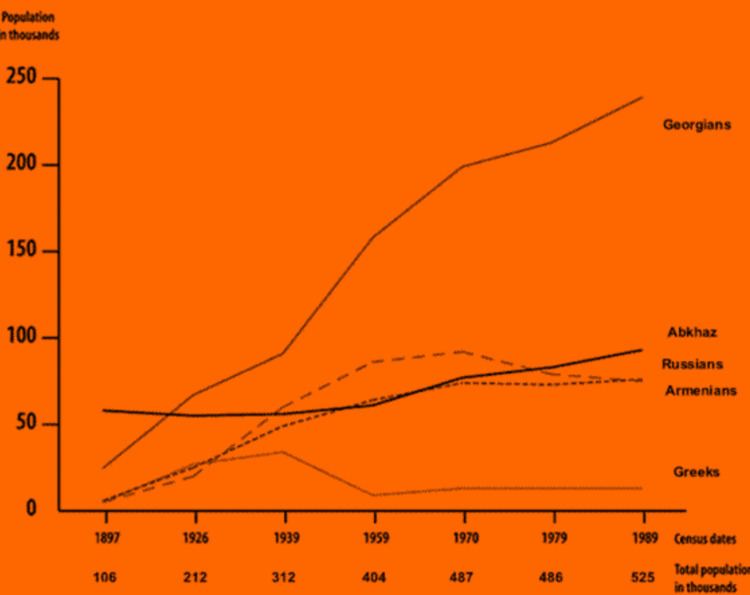 | ||
This article is about the demographic features of the population of Abkhazia, including population density, ethnicity, education level, health, socioeconomic status, religious affiliations and other aspects of the population.
Contents
The demographics of Abkhazia were very strongly affected by the 1992-1993 War with Georgia, which saw the expulsion and flight of over half of the republic's population, measuring 525,061 in the 1989 census. The ethnic composition of Abkhazia in past and current times plays a central role in the Georgian-Abkhazian conflict.
Size
The exact present size of Abkhazia's population is unclear. According to the census carried out in 2003 it measured 215,972 people, but this is contested by Georgian authorities. The Department of Statistics of Georgia estimated Abkhazia's population to be approximately 179,000 in 2003, and 178,000 in 2005 (the last year when such estimates were published in Georgia).
Encyclopædia Britannica estimates the population in 2007 at 180,000 and the International Crisis Group estimates Abkhazia's total population in 2006 to be between 157,000 and 190,000 (or between 180,000 and 220,000 as estimated by United Nations Development Program in 1998).
The size of Abkhazia's population more than halved due to the 1992-1993 war - at the time of the 1989 census it had measured 525,061.
According to the last census in 2011 Abkhazia had 240,705 inhabitants.
Ethnic composition
The population of Abkhazia remains ethnically very diverse, even after the 1992-1993 War. At present the population of Abkhazia is mainly made up of ethnic Abkhaz, Georgians (mostly Mingrelians), Hamshemin Armenians, and Russians. Prior to the war, ethnic Georgians made up 45.7% of Abkhazia's population, however, by 1993, most Georgians and some Russians and Armenians had fled Abkhazia or had been ethnically cleansed.
Historical developments
The earliest reliable records for Abkhazia are the Family Lists compiled in 1886 (published 1893 in Tbilisi), according to which the Sukhum District's population was 68,773, of which 30,640 were Samurzaq'anoans, 28,323 Abkhaz, 3,558 Mingrelians, 2,149 Greeks, 1,090 Armenians, 1,090 Russians, 637 Estonians and 608 Georgians. Samurzaq'ano is a present-day Gali district of Abkhazia. The ethnicity of Samurzaq'anoans is disputed. But the comparison of 1886 figures clearly shows that they were Abkhaz. The Family Lists compile additional summary tables, and in these, Samurzaq’anoans are not listed, but the number of Abkhaz in Kutais province is given as 60,432. In Batum district (which was part of Kutais province) 1,469 Abkhaz were listed. Thus 58,963 remain—clearly, these are the Abkhaz plus the Samurzaq’anoans in Sukhum district. Nowadays Samurzaq'anoans are linguistically assimilated with Mingrelians.
According to the 1897 census there were 58,697 people in Abkhazia who listed Abkhaz as their mother tongue, 23,810 people listed Mingrelian as their mother tongue, 1,971 people listed Georgian (including Imeretian dialect) as their mother tongue. The population of the Sukhumi district (Abkhazia) was about 100,000 at that time. Greeks, Russians and Armenians composed 3.5%, 2% and 1.5% of the district's population. By the end of the nineteenth century, Abkhazians made up slightly more than 53% of the population of Abkhazia. According to the 1917 agricultural census organized by the Russian Provisional Government, Georgians and Abkhaz composed 41.7% (54,760) and 30,4% (39,915) of the rural population of Abkhazia respectively. At that time Gagra and its vicinity were not part of Abkhazia.
During the Soviet Union, the Russian, Armenian, Greek and Georgian population grew faster than the Abkhaz, due to the large-scale migration enforced especially under the rule of Joseph Stalin and Lavrenty Beria, who himself was a Georgian born in Abkhazia.
In 2008 almost all of the circa 2000 Svans in the upper Kodori Valley fled Abkhazia when this tract of land was conquered by the Abkhazian army during the August war. The Abkhazian authorities have appealed for the Svan refugees to return, but by late March 2009 only 130 people continued to live in the upper Kodori Valley. In their ethnic cleansing of Abkhazia, the Abkhazians concentrated on expelling ethnic Georgian settlers, which they considered illegitimate residents of the country, while being more lenient on native Svan and Mingrelians, but these other groups feel at unease in Abkhazia due to their ethnic kinship to Georgians and anti-Georgian sentiment.
In 1993, during the military conflict, nearly all Samurzaq'anoans left Abkhazia, however after some time nearly all came back.
The Abkhazian government has been trying to attract members of the Abkhaz diaspora (mainly in Turkey). In August 2013, the State Committee for Repatriation announced that since 1993, 7365 diaspora members had returned to Abkhazia, of which 4268 from Turkey, 494 from Syria, 107 from Egypt and Jordan and 2496 from Russia and other countries.
In September 2014, the Ministry of Internal Affairs of Abkhazia announced that 273 Ukrainians fleeing the War in Donbass had come to Abkhazia.
The following tables summarise the results of the censuses carried out in Abkhazia.
